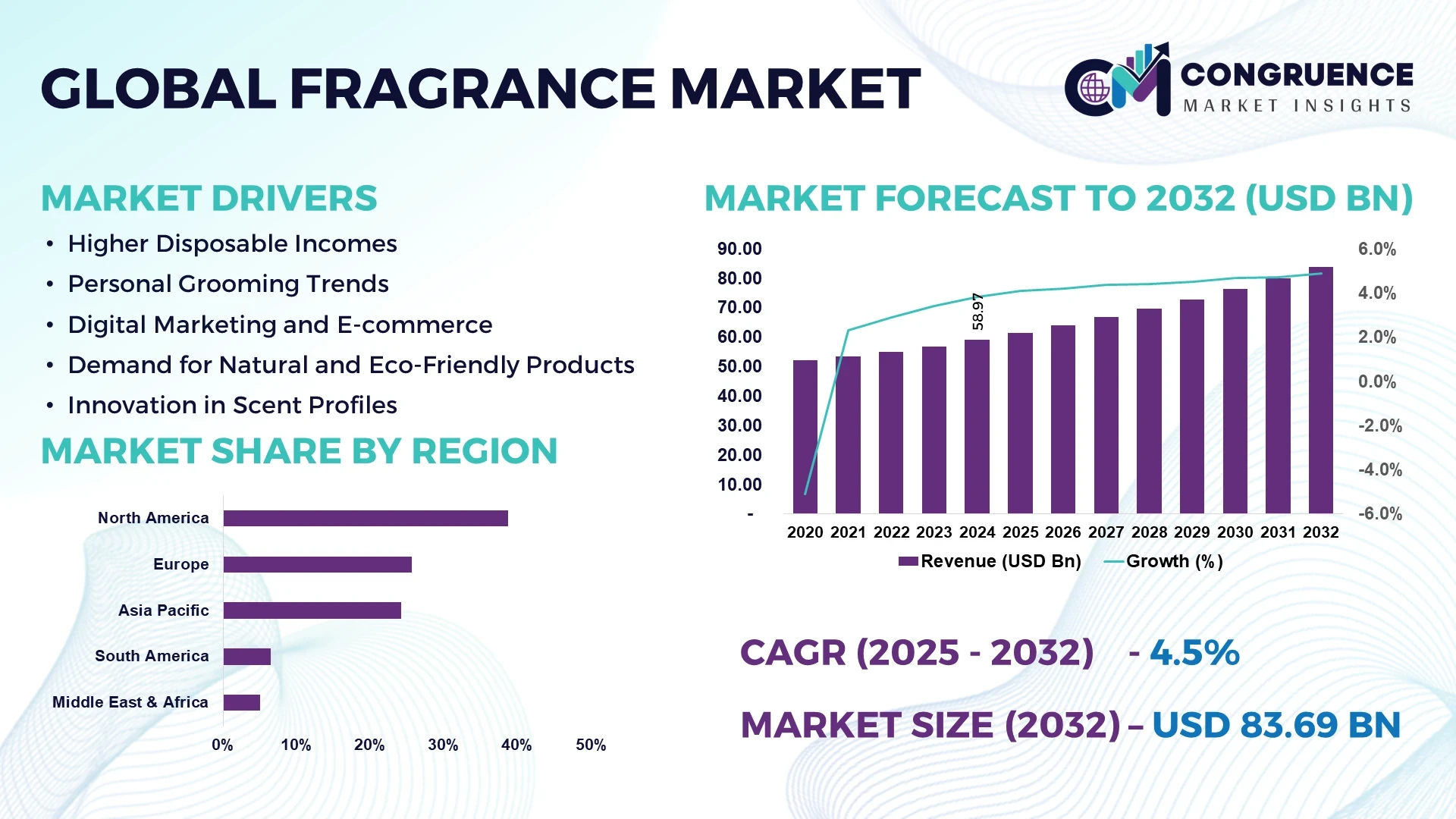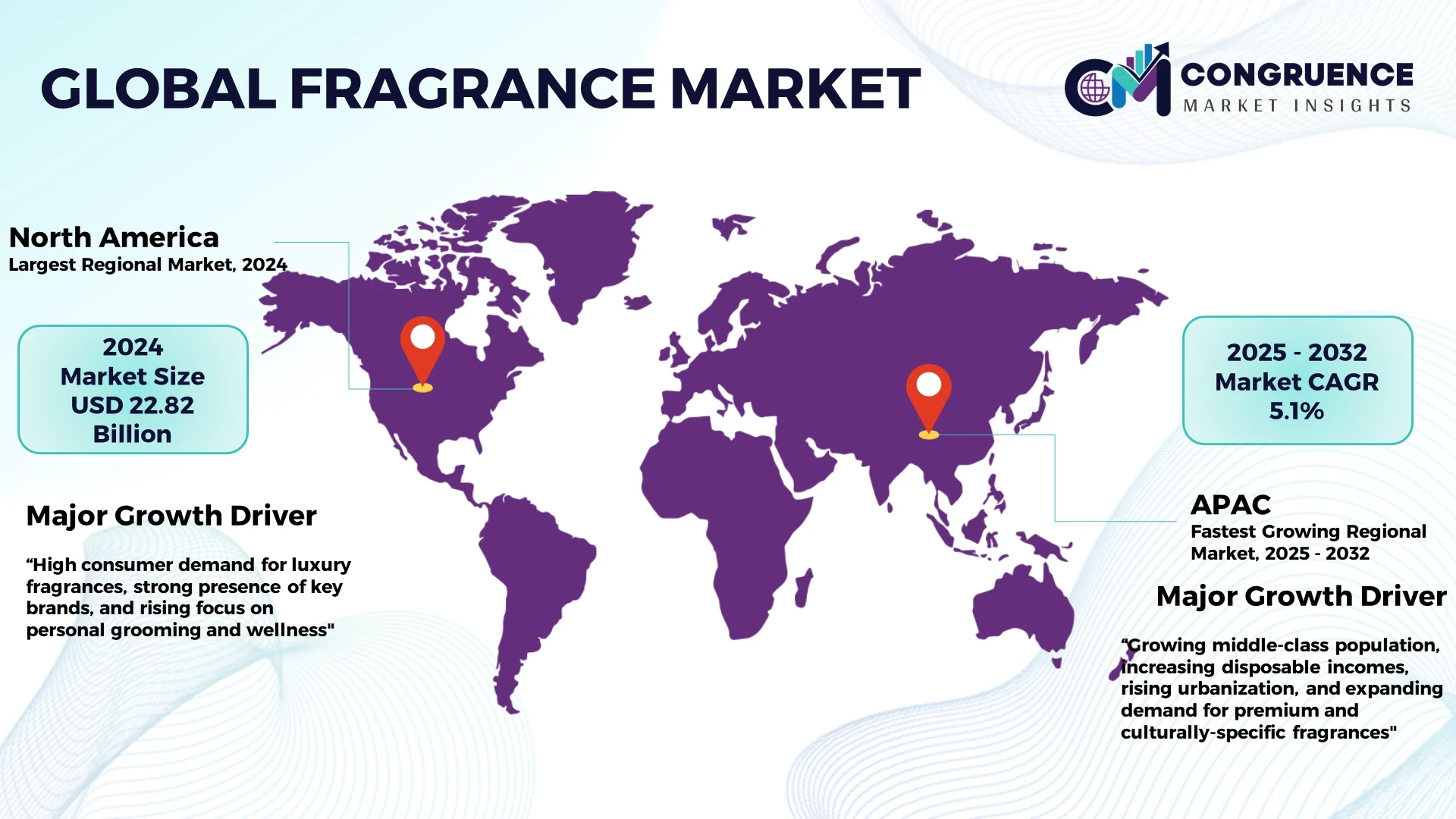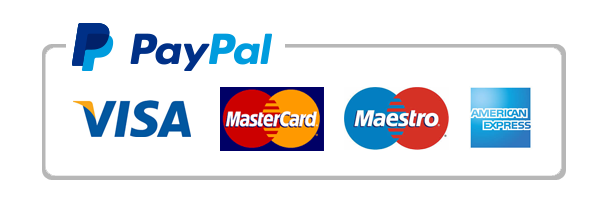Reports
Fragrance Market Size and Forecast 2025 to 2032
The Global Fragrance Market is valued at USD 58.97 Billion in 2024 and is projected to reach USD 83.69 Billion by 2032, growing at a CAGR of 4.5% during the forecast period between 2025 and 2032.

To Learn More About This Report, Request A Free Sample Copy
The expanding need for personal care products, the rising appeal of premium fragrances, and greater consumer interest in grooming and self-care are all major drivers of market expansion. Consumers, particularly in urban areas, are increasingly selecting premium and niche fragrance items, with individualized and long-lasting scents gaining popularity. The growing use of fragrances in household items, air care, and cosmetics also boosts the market. North America and Europe are dominating due to their established scent industries, but Asia Pacific is expected to experience the quickest development due to rising disposable incomes, increased awareness, and urbanization. The increased emphasis on natural and environmentally friendly perfumes creates new prospects for market growth.
The fragrance market includes perfumes, deodorants, body sprays, and other scented items for personal and domestic usage. The fragrance industry is expanding rapidly worldwide as people place a greater emphasis on personal hygiene, luxury living, and wellness. Consumers are increasingly drawn to high-end scents as well as environmentally concerned, sustainable products. Modern fragrance consumers want items that not only appeal to their senses but also reflect their ideals, such as clean beauty and sustainability. Furthermore, technical improvements have enabled the development of long-lasting, individualized smells that cater to individual preferences, hence encouraging industry innovation. Changing lifestyles, more disposable incomes, and the expanding influence of digital platforms are driving up demand, particularly among millennials and Generation Z consumers. As a result, fragrance producers are adopting new product formats, sustainable ingredients, and digital marketing to remain competitive in a fast changing market.
How AI is Transforming Fragrance Market
Artificial intelligence (AI) is transforming the fragrance industry by allowing for tailored smell creation, optimizing production processes, and improving consumer experiences. AI-powered algorithms are being used to study consumer preferences, allowing marketers to create bespoke fragrance suggestions based on individual likes, lifestyles, and even emotions. This personalization provides consumers with unique and individualized experiences, boosting brand loyalty and engagement. AI also helps to optimize fragrance creation. Companies can use machine learning to more accurately foresee trends and consumer requests. This reduces waste, optimizes raw material use, and improves sustainability practices, resulting in more efficient production cycles.
In terms of marketing, AI-powered solutions assist fragrance manufacturers in analyzing social media behavior, monitoring customer sentiment, and tailoring their marketing efforts accordingly. AI can also improve the online buying experience by providing virtual fragrance trials, which allow customers to try various scents from the comfort of their own homes. Furthermore, AI improves scent formulation by identifying optimal constituent combinations faster and more precisely. This results in smell innovation and the creation of one-of-a-kind, complex perfumes that appeal to consumers. As AI technologies advance, they will play a greater role in influencing the future of the fragrance industry.
Fragrance Market Major Driving Forces
· Higher Disposable Incomes: Rising disposable incomes, particularly in emerging countries, are driving demand for premium and luxury fragrances. Consumers are willing to pay for high-quality, long-lasting perfumes as a status symbol and personal delight.
· Personal Grooming Trends: As consumers become more conscious of the need of personal hygiene, grooming, and self-care, demand for perfumes, deodorants, and body sprays increases. Fragrances are regarded as a vital component of personal care practices.
· Digital Marketing and E-commerce: With the rise of digital marketing and e-commerce platforms, fragrance businesses' reach has expanded. Online platforms provide quick access to a variety of product possibilities, increasing sales and brand visibility.
· Demand for Natural and Eco-Friendly Products: Consumers are increasingly looking for fragrances manufactured with natural, sustainable, and cruelty-free components, which aligns with the larger trend of eco-conscious living. This trend is prompting brands to create more ecologically friendly formulas.
· Innovation in Scent Profiles: Fragrance manufacturers are innovating by delivering unique, complex scent profiles and bespoke fragrance experiences to appeal to niche audiences and provide more customization possibilities.
Fragrance Market Key Opportunities
· Expansion into Emerging Markets: Rapid urbanization, rising disposable incomes, and increased consumer awareness in emerging economies like China, India, and Southeast Asia provide major growth potential for fragrance companies. These regions are experiencing increased demand for both mass-market and premium scent goods.
· Sustainability Initiatives: As the focus on sustainability grows, firms have the opportunity to offer eco-friendly scents produced from natural, biodegradable, and cruelty-free materials. Consumers are increasingly choosing products with less environmental impact, resulting in a need for green scents.
· Personalized Perfumes: The trend toward personalized and customizable perfumes opens up chances for businesses to create AI-powered platforms that provide tailored smell solutions, increasing customer engagement and brand loyalty.
· Packaging Innovations: Brands can differentiate their products through creative and sustainable packaging solutions. Refillable bottles, recyclable materials, and simple designs can appeal to environmentally concerned customers while also contributing to a brand's sustainability narrative.
Fragrance Market Key Trends
· The Growing Popularity of Niche Fragrances: There is a growing trend for niche and artisan fragrances with distinctive and uncommon aroma profiles. Consumers want items that reflect their unique personalities and styles, which is fueling demand for exclusive perfumes.
· Sustainability and Clean Beauty: As sustainability becomes a top priority, manufacturers are incorporating natural and sustainable components into their formulas. The popularity of "clean beauty" products has increased demand for eco-friendly, cruelty-free, and vegan scents.
· Gender-neutral scents: Unisex or gender-neutral scents are gaining popularity, breaking down traditional gender barriers in fragrance preferences. Consumers are embracing scents that appeal to all genders, which adds to market variety.
· Premiumization and Luxury: The trend toward premiumization is boosting demand for luxury perfumes, as consumers are ready to spend more for rare, high-quality scents that reflect status and elegance.
· Digital Fragrance Discovery: Virtual try-on tools, AI-powered scent recommendations, and online fragrance consultations make it easier for customers to discover new smells via digital platforms.
Region-wise Market Insights
North America is identified as the largest market, at 38.7% of the market share in 2024, valued at USD 22.82 Billion. However, Asia Pacific is predicted to expand at a fastest CAGR of 5.1% between 2025 and 2032.

To Learn More About This Report, Request A Free Sample Copy
North America has the greatest market share, accounting for 38.7% of the worldwide fragrance market in 2024 (valued at USD 22.82 billion). The region's dominance is fueled by high demand for premium and luxury perfumes, cutting-edge e-commerce platforms, and creative product introductions. The United States remains a vital player in the region, with major companies concentrating on sustainable and eco-friendly scents to meet the growing demand for natural and cruelty-free options.
Asia Pacific is the fastest-growing region, with a predicted 5.1% CAGR from 2025 to 2032. Rising disposable incomes, urbanization, and the growing popularity of personal grooming are important drivers of the fragrance business in nations such as China, India, and Japan. The region is seeing an increase in demand for both budget and premium fragrances, with local and international businesses extending their presence to meet changing consumer preferences.
· In April 2024, L'Oréal is reportedly considering acquiring a stake in Amouage, a luxury perfume brand valued at $3 billion. This move would strengthen L'Oréal's position in the high-end fragrance market.
The fragrance market in Europe is driven by a long legacy of perfumery, with France, Italy, and the United Kingdom dominating in scent production and consumption, respectively. Sustainable and eco-conscious scents are gaining popularity in this region, with customers preferring organic and environmentally friendly alternatives.
Recent Market Developments
· In February 2024, L'Oréal revealed its new Art & Science fragrance collection, blending advanced technology and artistic expression. This collection pushes the boundaries of scent creation by combining cutting-edge innovation with the timeless art of perfumery, offering consumers unique olfactory experiences.
· In November 2023, L'Oréal and Cosmo International Fragrances announced their collaboration to harness green science for unlocking new olfactory experiences. This partnership focuses on creating sustainable fragrance ingredients by utilizing bioengineering and nature-inspired processes, aiming to reduce environmental impact while enhancing scent quality.
· In August 2023, Chanel expanded its Chance fragrance line with the launch of Eau Fraîche Eau de Parfum. The new scent offers a refreshing and vibrant take, featuring a blend of zesty citrus notes balanced with floral undertones, bringing a youthful and energizing addition to the collection.
Market Competition Landscape
The worldwide fragrance market is fiercely competitive, with leading firms prioritizing product innovation, sustainability, and development into new markets. Key market participants are investing in natural and eco-friendly ingredients, as well as sustainable packaging, to meet customer demand for clean beauty and ecologically responsible goods. Brands are also using digital platforms to increase consumer engagement and improve the online purchasing experience by offering virtual scent sampling and AI-powered recommendations.
The competitive landscape is characterized by the presence of both global giants and niche brands. Premiumization is a big trend, with corporations introducing high-end, luxury scents to appeal to affluent customers. Furthermore, the need for gender-neutral and customizable perfumes is propelling product innovation. Additionally, companies are using mergers, acquisitions, and partnerships to boost their market position and expand their distribution networks, especially in rising markets like Asia Pacific and Latin America.
Key players in the global fragrance market implement various organic and inorganic strategies to strengthen and improve their market positioning. Prominent players in the market include:
· Chanel
· L'Oréal
· Estée Lauder
· Coty Inc.
· Shiseido
· Unilever
· Puig
· Givaudan
· Firmenich
· Symrise
· IFF (International Flavors & Fragrances)
· Avon Products
· Revlon
|
Report Attribute/Metric |
Details |
|
Market Revenue in 2024 |
USD 58.97 Billion |
|
Market Revenue in 2032 |
USD 83.69 Billion |
|
CAGR (2025 – 2032) |
4.5% |
|
Base Year |
2024 |
|
Forecast Period |
2025 – 2032 |
|
Historical Data |
2020 to 2024 |
|
Forecast Unit |
Value (US$ Bn) |
|
Key Report Deliverable |
Revenue Forecast, Growth Trends, Market Dynamics, Segmental Overview, Regional and Country-wise Analysis, Competition Landscape |
|
Segments Covered |
· By Product Type (Perfumes, Deodorants, Body Sprays, and Others) · By Application (Personal Care, Household Care, Cosmetics, and Others) · By Distribution Channel (Online Retail, Specialty Stores, Hypermarkets /Supermarkets, and Others) · By End-User (Men, Women, and Unisex) |
|
Geographies Covered |
North America: U.S., Canada and Mexico Europe: Germany, France, U.K., Italy, Spain, and Rest of Europe Asia Pacific: China, India, Japan, South Korea, Southeast Asia, and Rest of Asia Pacific South America: Brazil, Argentina, and Rest of Latin America Middle East & Africa: GCC Countries, South Africa, and Rest of Middle East & Africa |
|
Key Players Analyzed |
Chanel, L'Oréal, Estée Lauder, Coty Inc., Procter & Gamble, Shiseido, Unilever, Puig, Givaudan, Firmenich, Symrise, IFF (International Flavors & Fragrances), Avon Products, and Revlon |
|
Customization & Pricing |
Available on Request (10% Customization is Free) |
